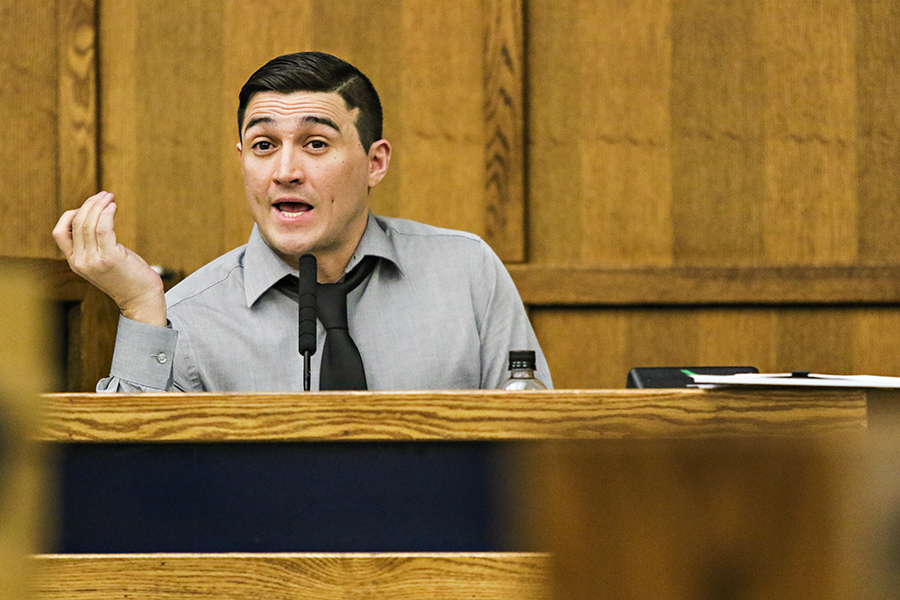Montana Supreme Court Halts Ryan Lamb Murder Case
After Flathead County judge rejected a motion to dismiss case, Ryan Lamb’s defense team makes “extraordinary” appeal to the Montana Supreme Court
By Justin Franz
The Montana Supreme Court has halted the legal proceedings of a Kalispell man accused of murder after his attorneys asked the state’s top court to review a lower court judge’s decision to not dismiss the case after declaring a mistrial.
In June, 34-year-old Ryan Lamb stood trial for stabbing his boyfriend during a sexual act in 2018. After nine days of testimony and 13 hours of deliberation, the jury was unable to reach a verdict. Flathead County Judge Robert Allison declared a mistrial, setting the stage for a new trial in 2020.
But soon after the trial, Lamb’s attorneys filed a motion to dismiss, arguing that having their client stand trial again would be a violation of the double jeopardy clause of the constitution. Judge Allison rejected that motion.
Now, in what state prosecutors called an “extraordinary” move, Lamb’s defense team is using a century-old statute called the writ of supervisory control to appeal the decision to the Montana Supreme Court.
The Montana Supreme Court’s writ of supervisory control dates back to the early 20th century. Chief Justice Theodore Brantly created the unique rule in December 1900 as a way to review interlocutory rulings by Butte judges who had been bought off by corrupt Copper Kings.
In the petition for writ of supervisory control filed on Sept. 16, public defender Greg Rapkoch argued that Judge Allison should have never declared a mistrial after just 13 hours of deliberation.
On June 14, the 12 jurors in the Lamb trial informed the court that they were deadlocked and needed additional instructions about the law. Judge Allison said he was unable to give the jury supplemental information and never inquired with the jury about what their precise questions or concerns were. But Rapkoch argues that the law does allow a judge to give additional legal information to a jury to help them reach a verdict.
“The court erroneously concluded that supplementary instruction could not be offered and the court failed to employ a reasonable process in determining whether the ‘definition’ or ‘clarification’ sought by the jury was permissible,” Rapkoch wrote.
The motion for supervisory control also reveals that there was a previously undisclosed jury question in the court file. During the course of the 13 hours of deliberation, the jury sent more than a half dozen notes to the court — either statements about their progress, questions about the law or requests to see specific pieces of evidence. However, according to Rapkoch, there was one question that was never addressed by the court or shared with attorneys. That note — “What if a juror states he made a conclusion before all evidence is presented?” — came out of the jury room at the same time as a note announcing that they were still deadlocked.
A week after Rapkoch filed his motion to the Montana Supreme Court, the high court filed an order to have the case stayed, thus halting all proceedings until further notice.
On Oct. 23, Assistant Attorney General Mardell Ployhar filed a response to the petition for a writ of supervisory control. In it, the attorney argued that Judge Allison was right to declare a mistrial and reject the motion to dismiss the case. Ployhar argued that keeping the jury in deliberation — which prior to the declaration of a mistrial was split with 11 in favor of acquittal and one against — possibly would have “been unwise … given the potential for a juror to change the juror’s vote based on the pressure rather than considered judgment.”
The attorney also notes “it is significant” that the defense team never objected to the judge’s declaration of a mistrial in court.
“Instead, the record demonstrates that the court exercised sound discretion and properly declared a mistrial based on a hung jury,” Ployhar wrote.
The decision by the Montana Supreme Court to review Judge Allison’s actions means the Lamb case is at a standstill until the high court issues a ruling, dragging out what has already been a long legal drama.
Lamb was arrested after he stabbed and killed his partner, Ryan Nixon, 31, with scissors during a sexual encounter in August 2018 at their apartment in Kalispell. Lamb was charged with a single count of deliberate homicide. Prosecutors allege that Lamb enjoyed violent sex and the use of the scissors as part of that. But the defense argued that Lamb was acting in self-defense and that Nixon was an abusive partner.
In an interview with the Beacon after the trial, one of the jurors, Nikki Streeter, said the group struggled with the prosecutor’s decision to charge Lamb with deliberate homicide instead of negligent homicide. Asked if she thought Lamb would have been convicted had the Flathead County Attorney’s Office charged him with negligent homicide, she said, “It would have been over in 15 minutes.”
“The deliberate homicide charge made it much more difficult for us,” she said. “It was never a question in my mind that he was guilty; it just came down to the fact that he was charged with deliberate homicide.”
After the mistrial, the county attorney’s office filed an alternative charge of negligent homicide, which means a jury could acquit Lamb of the deliberate homicide charge and instead convict him of the lesser charge. Lamb has pleaded not guilty to the alternative negligent homicide charge.
Lamb is currently out on bail.